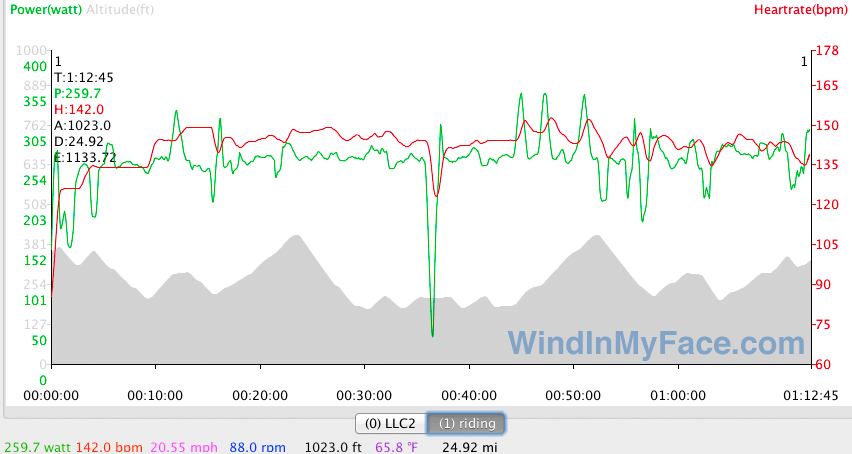Thoughts on Higher Power / Wattage and Physiological Demands
My bike fitting experience showed a bump up in power by ~20-25 watts with the same perceived exertion.
The power increase came via positioning changes that allowed the largest muscles (gluteus and quadriceps) to be better utilized. No magic there, just efficiency with the same ol' body. Which is a magical and wondrous thing to enjoy.
Larger muscles can produce the same amount of power more aerobically (fat burning) than can smaller muscles, which are forced into anaerobic energy production sooner (anaerobic = without oxygen, lactate forming).
But cycling power is not generated without a corresponding increase in physiological demands; higher power output demands greater inputs: increased muscular demand for oxygen translates to a higher heart rate and faster respiration rate.
Discussion continues below.
Aerobic energy and fueling
Subjective feel and actual fueling needs along with power meter data tell me that I am generating more power and more power aerobically (by burning fat). Burning more fat per generated watt makes the body’s stored muscle and liver glycogen last longer.
Even after a long (3 hour) ride, I feel a reduced need to take an energy gel or similar product. I noticed this right away, but initially discounted it as just being “well fueled” that day. Not so— with enough rides in now, the effect is remarkably consistent: I feel a distinctly reduced need to consume an energy gel or similar product, arriving home some days not having eaten anything at all on my 90-120 minute rides. This is a significant change.
Operating aerobically is of considerable significance to longer events where it is all too easy to exhaust muscle and liver glycogen stores— the body is able to assimilate only ~200-300 calories per hour; that’s about 1/3 of my hourly caloric needs at a steady vigorous pace, meaning that the rest has to come from somewhere else (fat and protein metabolism).
For long events— a double century or a race like the Everest Challenge— performance is decided by how many watts the body can make aerobically, because it is impossible to assimilate enough carbohydrate energy during the event: the major source of energy therefore is aerobic (fat burning with some contribution via gluconeogenesis and catabolic destruction of muscle tissue).
* Gluconeogenesis is a metabolic pathway that results in the generation of glucose from non-carbohydrate carbon substrates such as pyruvate, lactate, glycerol, and glucogenic amino acids.
Heart rate and breathing
At the same wattage as before the bike fit changes, my heart rate is similar, but since my new easy to moderate pace is now on the order of 20-30 watts higher (10-15%), it is natural to find a correspondingly higher heart rate and breathing rate for my average ride.
The body cannot produce 20-30 more watts (output) without increased oxygen and fuel availability (inputs), which means a higher heart rate and higher respiratory rate: 12% more power (aerobically) means oxygen demands are 12% higher. To deliver that oxygen to muscles, blood flow must be about 12% higher (heart rate) and breathing rate must rise to acquire that oxygen (the body is not linear in its responses, but the basic idea holds).
All of which leads me to the next idea.
Will the cardiovascular system rise to the challenge?
Suddenly my cardiovascular system is experiencing 10% - 15% higher sustained demands for oxygen and thus blood flow on everyday rides: 141 beats per minute instead of 125 bpm (estimated difference).
Will my heart adapt to this higher average load by increasing its stroke volume (more blood per beat)?
As 2013 unfolds, it will be interesting to observe whether heart rate adapts to the higher load. And whether this increases the headroom for the hardest efforts , and whether there is also a reduction in max heart rate.
Moreover, as leg muscles adapt to the new position, bigger muscles might react by getting bigger and stronger, thus putting even more demands on the cardiovascular system. I’ll be watching all my data carefully.




